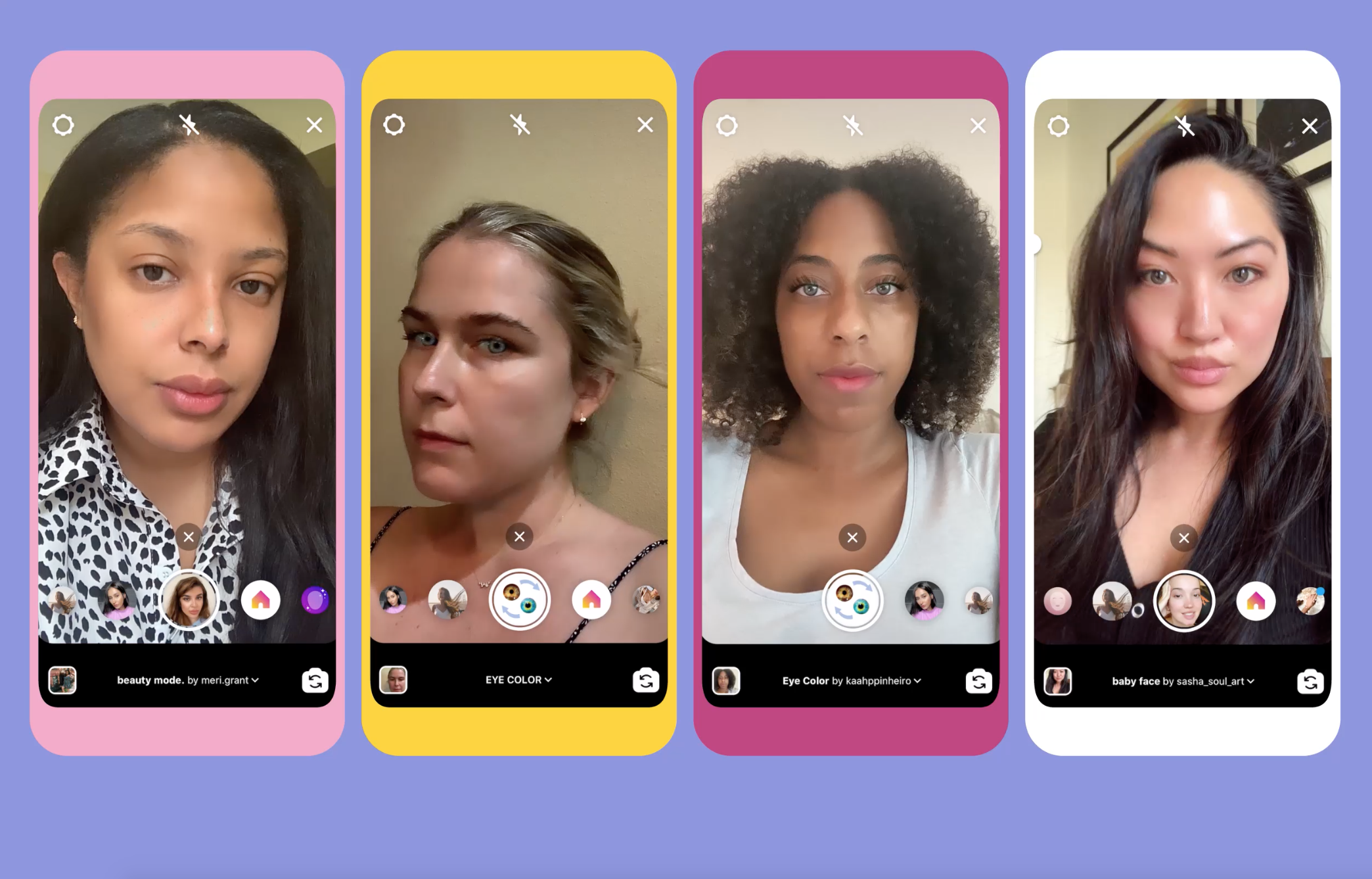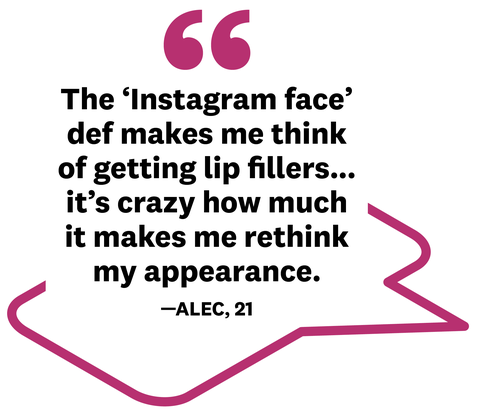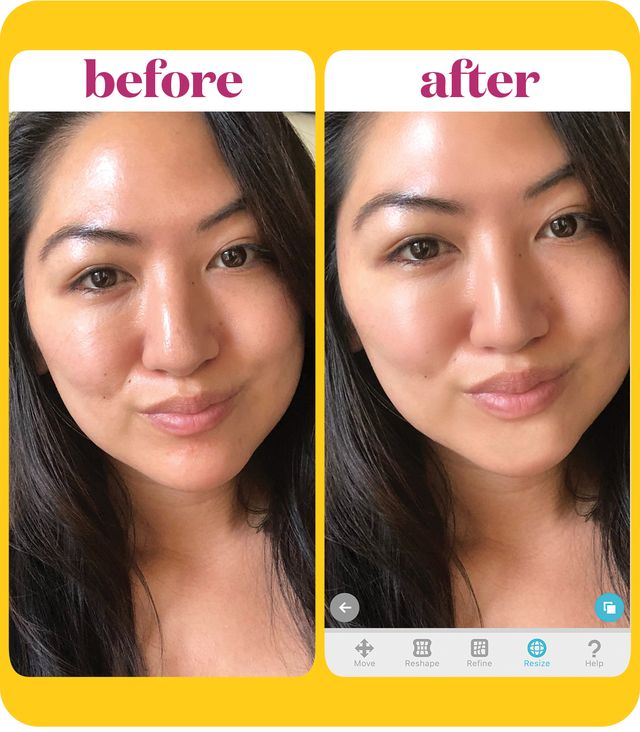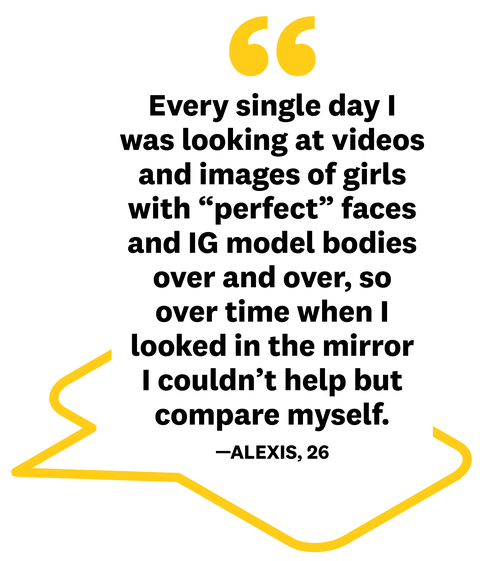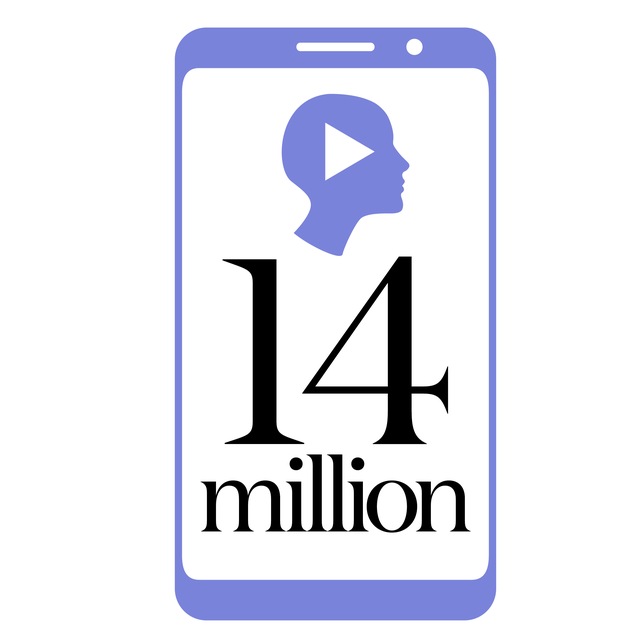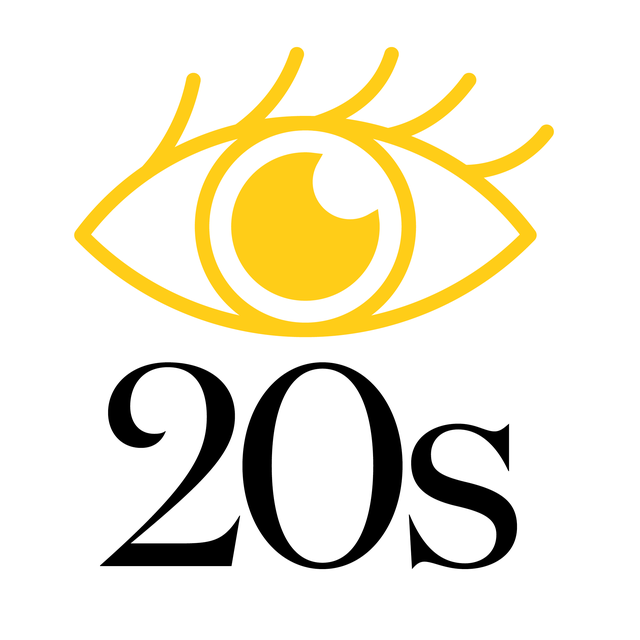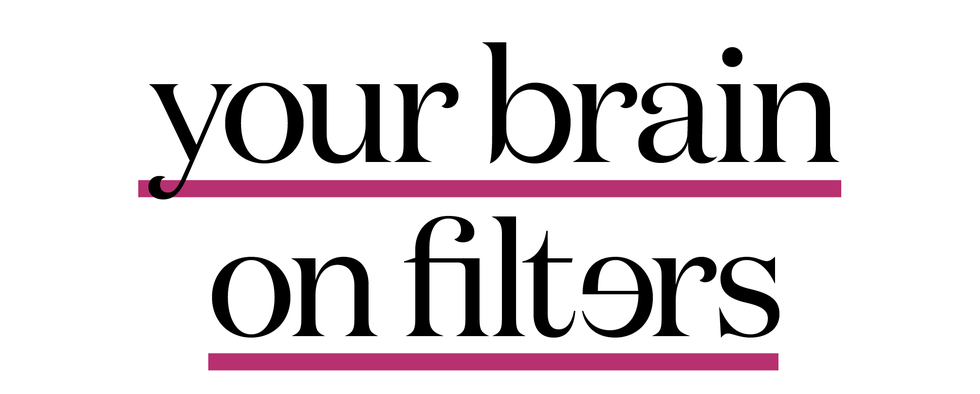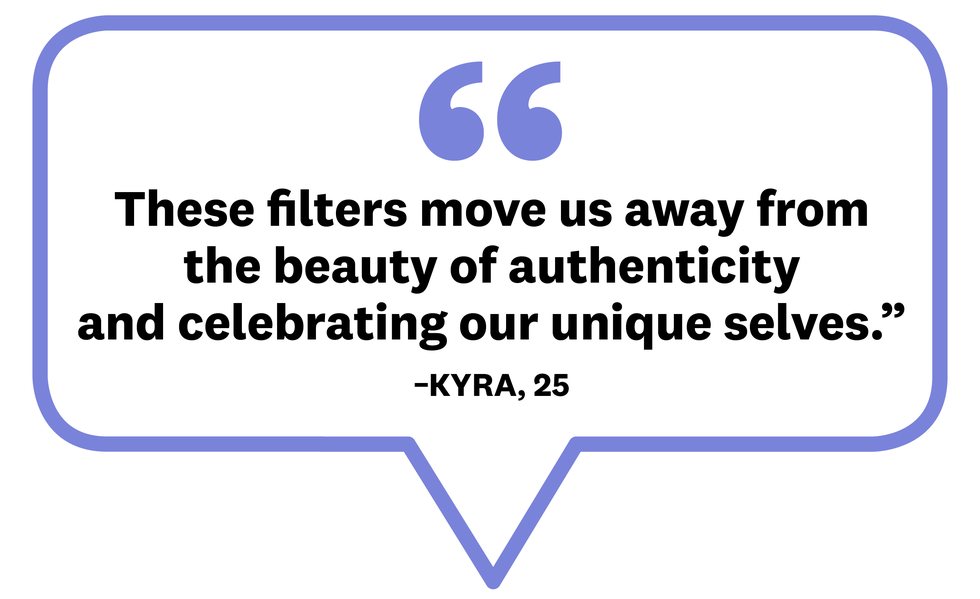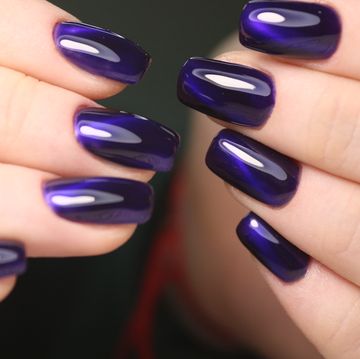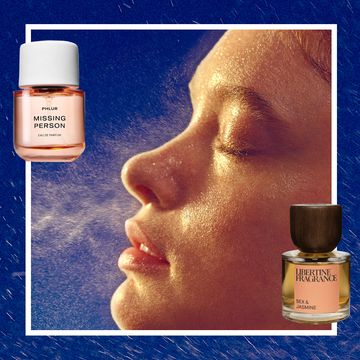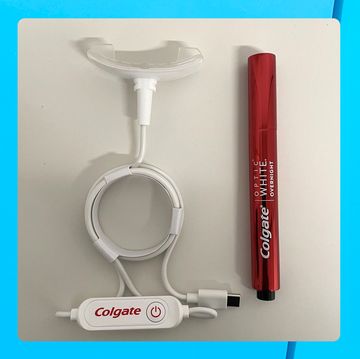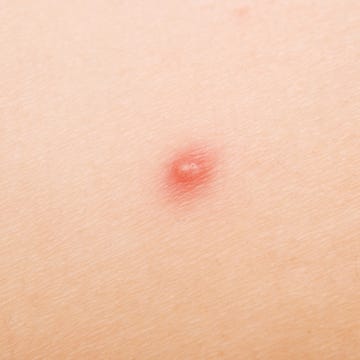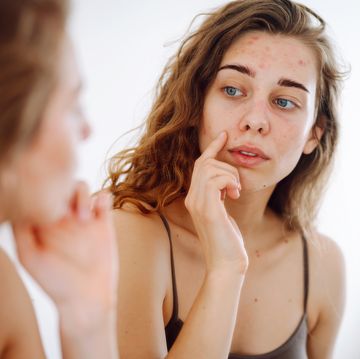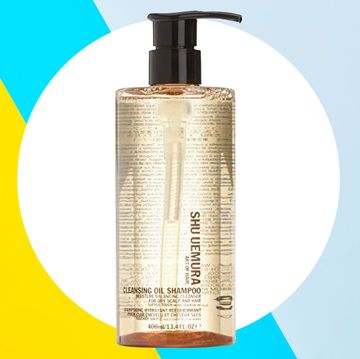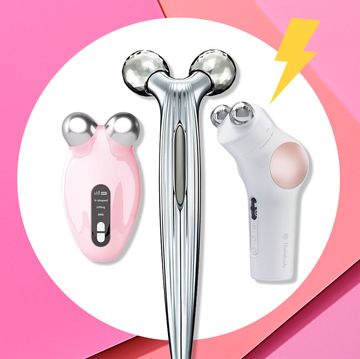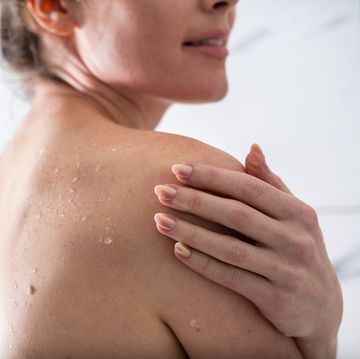“Should I get lip injections?” is a question that runs through my mind almost every time I use Instagram (that is, up to 24 hours a week). The truth is, the natural pout I was born with is one of my favorite features. But if I spend long enough scrolling through filtered-to-perfection influencers, celebrities, and regular people I know who take a damn good picture, it’s very tempting to start a mental wish list of things I could change: a more defined jawline, higher cheekbones, smoother skin, the list goes on. This all-too-familiar spiral has only been amplified in 2020 as my screen time–like everyone else’s–has gone up dramatically.
In the era of social distancing, former simple pleasures, like travel, going to a bar, attending concerts, and more, halted. Forced to transform our homes into hubs for work and play, life has hit peak virtual: We go on FaceTime dates. We attend Zoom weddings. We celebrate Houseparty birthdays. We have telemedicine checkups with doctors. We livestream remote workout classes from our favorite fitness instructors.
In the first month of lockdown, Internet provider Comcast reported a 60 percent increase in its peak network traffic in some regions. Meanwhile, Instagram was the second-most-used social platform, with about 50 percent of U.S. adults (!) active as of March. (Facebook, its parent company, occupied the top spot.) This means we could be staring at—and, inevitably, evaluating—our faces more than ever. In a world where even Zoom (the video-conferencing app’s number of users reportedly surged by the millions in April alone) has a “touch up my appearance” option, how much does this selfie-gazing damage our mental health? All signs point to…a whole lot. “There’s a well-established link between social-media usage and psychological concerns,” says Peace Amadi, PsyD, an associate psychology professor at Hope International University in California. “Instagram has been tied to anxiety and depressive symptoms, but also to concerns such as anxiety related to physical appearance, increased body dissatisfaction, and lower self-esteem.” And now that we’re spending more minutes on these platforms, “we can assume these concerns have not only remained but increased,” Amadi says.
Take Alec Bayot, a 21-year-old in the Los Angeles area who has downloaded- and deleted Facetune “multiple” times. The editing app turns your face and body into digital Play-Doh, to mold, pinch, and add volume wherever you want. “I’m on social media basically 24/7. I make most of my hair, fashion, and beauty decisions based on what I see there, so it plays a big part in what I look like,” Bayot says.
Amanda Wilson, a 32-year-old in New York, also uses filters and Facetune often. She’s been leaning on them to keep up appearances, especially in isolation, since her real-life lip filler started dissolving as doctors’ offices remained closed. In the app, “I blur my skin, thin my face, and add a little plumpness in my lips,” she says. “It has for sure affected how I look at myself.”
These women are not alone in their usage—Facetune’s parent company, Lightricks, reported that as social distancing began, use of its apps increased 20 percent. Plus, people spent more than 25 percent more time than usual editing their videos. That’s on top of Facetune’s already outsize influence. (To give an idea: In late 2018, the company also reported 100+ million downloads across its apps; Facetune is the most popular one.)
Even if you’re not going out of your way to pay $3.99 for Facetune, you might be one of the 1 billion people using built-in face perfectors across Facebook, Instagram, Messenger, and Portal (these effects also exist on apps like Snapchat and TikTok). Filters such as “Paris” subtly blur out pores. Other user-made filters alter your face more dramatically in just a swipe, enlarging your eyes, slimming your nose, or sharpening your jawline. There’s even augmented-reality winged eyeliner, lashes, and lipstick.
“It seems harmless at first, but a slight edit here and a slight edit there can spiral into obsessive-compulsive tendencies around body image,” Dr. Amadi says. “These alterations divorce you from reality–nobody glows, sparkles, and has perfect abs 24/7 in real life.” The always-documenting culture we exist in already sets hard-to-reach beauty standards. And as this digital lens becomes our permanent reality, the way we see ourselves is massively shifting. But you can pull back and live happily ever after (on Insta, at least). Let’s filter the noise.
Social media–driven beauty trends have popularized a singular “Instagram Face” (the features seemingly appropriated from different ethnicities) and made it impossible to avoid. “It’s a scary phenomenon, as it has become a subconscious request that comes in daily through my practice,” says Shereene Idriss, MD, a dermatologist in NYC. “Patients nitpick their features apart and ask for a face that belongs to no one–but looks like 'everyone' on social media.” Here, the Instagram Face by the numbers…
71 Percent
How much lip augmentation procedures have increased since 2000. Big, plump Bratz doll–type lips achieved with dissolving hyaluronic acid fillers are a popular request—so much so that they were a large portion of the 2.7 million total filler procedures in 2019 alone.
$16.7 BILLION: How much Americans spent on cosmetic procedures in 2019. (American Society of Plastic Surgeons)
As more people embrace the no-makeup life, there’s likely a big difference between the way we appear IRL and our polished digital alter egos (see: that #TBT of you in lipstick living on your grid). That may be dangerous: “A widening gap between one’s digitally enhanced ideal self and one’s actual self creates a dysphoria,” says Dr. Amadi. “The chances of developing mental concerns and disorders like depression, anxiety, eating disorders, and OCD-related problems, including body dysmorphic disorder, also increase. It’s a slippery slope.”
It doesn’t help that the naked eye is gullible online. People recognize edited photos only 60 to 65 percent of the time while 12 percent of photos tagged #nofilter are, actually, filtered as one study found. “Some of the behaviors people engage in that inadvertently worsen their body image are ‘checking and avoidance’—using a filter is a perfect example of this,” says Terri Bacow, PhD, a psychologist in New York City. Editing your image reinforces a negative belief and “confirms the thought that your natural body is not acceptable or good enough.” That’s why Dr. Bacow suggests not using filters or any editing tools on photos, full stop. “This is called exposure therapy,” she says. “The idea is if you do something against something you believe—that you have to look perfect in all photos—your brain will be confused and try to resolve the conflict, which leads to a positive shift in perspective.”
Myla Bennett Powell, MD, a plastic surgeon in the Atlanta area, has a front-row seat on the magnification of body issues. Despite the interest in cosmetic procedures (in 2019, 18.1 million people in the U.S. had noninvasive treatments and surgery), she often turns people away. Below are three reality checks she gives prospective patients to help anyone think twice about desired changes:
Is the issue on your face, or deeper?
“Everyone’s trying to be selfie-ready all the time—they’re asking for cheek filler when their cheeks are sitting underneath their eyes already. Things have become so normalized that people treat it like they’re buying jeans. I end up ‘mothering’ people who come into my office and sending them on their way. I don’t enjoy seeing women pick themselves apart and break down their self-esteem comparing themselves to images they saw on Instagram—which happens a lot. So if I see a hint of something that needs to be handled with a therapist first, I won’t proceed, especially if they’re young.”
Just because you can do a procedure doesn’t mean you should.
“I try to neutralize feelings as best I can. Many women scroll past somebody they perceive as better than them. It’s like they’re looking through a cracked mirror.If you’re modifying the physical based on a distorted image you’re seeing, that’s a major problem.”
You need to know who you are inside before you tackle the outside.
“People will come to me, especially women in their 40s, and say, ‘It’s time for me to take care of myself.’ To me, the first thing you think of when you’re taking care of yourself shouldn’t be physical. This often happens after someone has gone through a bad breakup or a divorce and feels they need to get something done. We should be putting that energy into our inner self first. When you do it in that order, you don’t end up in a position where you’re putting yourself in danger to get a procedure (yes, it all comes with risk!). In other words, you’re not going to put yourself in a desperate situation, because you already love yourself and fully believe you are worthy and amazing—whether or not you have big lips.”
Katharine Phillips, MD, a professor of psychiatry at NewYork-Presbyterian and Weill Cornell Medicine and leading expert on Body Dysmorphic Disorder (BDD), answers this question.
WH: Could using appearance-changing filters and apps contribute to developing BDD?
Dr. Phillips: Well, using the word contribute here is important because Instagram filters alone won’t cause BDD. But for some people who are already at risk of developing it, they could tip them over the edge.
WH: How can you tell if you’re at risk for developing the prob?
Dr. Phillips: We have some clues, but we don’t fully know. Having been teased about your appearance or competence may be risk factors for developing it. BDD is actually partly genetic, so if you have a relative with BDD, that increases your risk too.
WH: What are the signs that your insecurities are turning into a disorder?
Dr. Phillips: BDD causes a preoccupation with perceived appearance defects that, to others, are non-existent or only slight. You may have BDD if you’re spending one hour-plus a day worrying about how you look and these thoughts make you distressed—sad, anxious, or self-conscious—or cause problems in your daily life like skipping social events, having trouble focusing, or getting less done at work. Excessively checking your appearance in reflecting surfaces, comparing yourself, seeking reassurance, or spending too much time on grooming are other BDD compulsions.
WH: And what about treatment? What works?
Dr. Phillips: A licensed pro like a psychiatrist who can prescribe medication, or a psychologist, can help. In general, the best ways to tackle it are cognitive-behavioral therapy that is tailored to BDD symptoms, and prescriptions (serotonin reuptake inhibitors, which are usually well tolerated and not habit-forming).
NEARLY 10 MILLION people in the U.S. have BDD. (International OCD Foundation)
Trying to beat the comparison beast can feel like running on a treadmill—
Heading nowhere. If you feel worse about yourself while scrolling, tap these expert-approved tactics to build more resilience and love what you see.
Check the Facts
“We get so used to viewing our appearance through a lens of negative self-image and filters that we don’t see what’s really there. We distort it in our mind,” says Alyssa Lia Mancao, LCSW, a Los Angeles–based therapist. Try this: “Look at yourself in the mirror and describe your appearance without using any subjective language,” she says. That means quelling the critical voice in your head (“my lashes are too short”) and describing yourself objectively (“I have two eyes”) or focusing on function (“my eyes allow me to see”).
Limit Your Use
Curate your feed! “Unfollow people that trigger unhelpful thoughts or feelings,” says Mancao. “It’s okay to mute the accounts that don’t make you feel good about yourself and start following accounts that make you feel better.” And when all else fails, log off.
Embrace Affirmations
The way you talk to yourself matters too. Use affirmations (i.e., first-person statements like “I don’t need to look perfect to be accepted by others”) and say them out loud. Stuck at what to focus on? “Sometimes it helps to give yourself ‘permission’ to do something,” Dr. Amadi says. “A powerful statement is: ‘I grant myself permission to love my body today.’ This helps you get out of your own way.”
Practice Mindfulness
This means increasing your awareness and acceptance and allowing negative thoughts and emotions to pass. View your thoughts as “clouds passing in the sky”—you notice their shapes and colors but just let them roll by, suggests Dr. Amadi. Likewise, when you see images that trigger anxiety, self-con-scious-ness, envy, sadness, or other negative emotions, take a breath and acknowledge them without judgment. “Note your thoughts, feelings, and reactions, and accept them as they are,” she says.
Give Gratitude
Or, practice self-appreciation. “Your body does more for you than anybody else ever could,” says Dr. Amadi. “Think about it. It should be honored and celebrated.” So the next time you catch yourself griping about your stomach or legs, redirect the conversation by offering a genuine thank you for how this part of your body has served you.
Connect With Your Values
Swap out vanity-based goals like “reduce wrinkles” to focus on values like “being healthy and happy.” Ground yourself by asking questions like, What’s important to me? What brings me joy? Who do I love? “Remember that appearance is just one aspect of who you are. Try to accept and value your assets,” Dr. Phillips says. “Is your best friend your best friend because she has a very symmetrical nose? Probably not. Relationships don’t work long-term because someone has perfect teeth.”
This article appears in the September 2020 issue of Women’s Health. Become a WH Stronger member for a print subscription and more great perks now.

Kristina Rodulfo is the Beauty Director of Women's Health—she oversees beauty coverage across print and digital and is an expert in product testing, identifying trends, and exploring the intersections of beauty, wellness, and culture. Prior to Women's Health, the Filipino-American, NYC native and NYU alumna was at ELLE.com for four years. As Senior Beauty Editor, she reported and co-produced the Webby Award-nominated documentary Beat: How Drag Queens Shaped the Beauty Industry and hosted the millions-viewed video series "Beauty Haul." She can never decide whether or not to get bangs, feels naked without winged eyeliner, and will never shut up about running the NYC Marathon.
